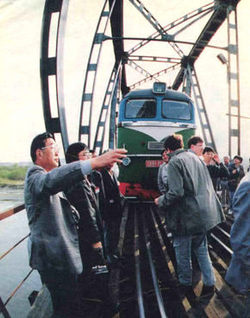 |
|
A Tumen River bridge that connects North Korea to Russia.
|
Land and sea routes being modernized
A train climbs a mountain pass toward China’s border city of Suifenhe, a center of trade. The train originated in Bogelaniqinei, a city in one of Russia’s maritime provinces. Every freight car is filled with lumber produced in Russia. Another passenger train heads back toward the Russian city, a number of Russia’s mom-and-pop store owners on board, nestled amid their cargo of clothing to be sold. About 10 years ago, Suifenhe was just one of China’s many outposts, but the city is now emerging as a fast-growing locus of trade, with a current population of 100,000. Two-way trade between Suifenhe, which accounts for 70 percent of foreign trade in the northeastern Chinese province of Heilongjiang, and Bogelaniqinei’s maritime province totaled 20 billion yuan (2.5 billion USD) in 2004. China and Russia are now deforesting to build a special trade zone in the Russo-Chinese border region on a land mass of 1.1 million square meters. In the Russian maritime provinces, Chinese restaurants and inns are popping up. In return, restaurants and inns in the border region of China are increasingly switching their signboards into cyrillic. The number of Chinese visitors to Vladivostok jumped to some 178,000 in 2004, compared with about 37,000 in 1995.A construction project is underway to build a major pipeline--the world’s longest, with a length of 4,200 kilometers--to transport oil from Russian fields to countries in Northeast Asia. The pipeline, which would carry 80 million tons of oil a year, will be routed through this region of Russia. Another pipeline, this one for natural gas, is also in the works. If land routes between Asia and Europe such as the Trans-Siberian railway and Trans-Korean railway are extended and completed, Russia’s maritime provinces may emerge as a strategic hub of the two continents in terms of population, energy, raw materials, and merchandise. Mikhail Vasiliyev, head of the Maritime Province Strategy Development Center, said, “The provincial government plans to build an oil refinery cluster with an annual processing capacity of 20 million tons at the end of the east Siberian oil pipeline.” He also expected railway freight volume in the region to grow by 70 percent when the Trans-Siberian and Trans-Korean railways are completed. In sharp contrast to the dynamic atmosphere at border cities between China and Russia, a railroad station in Hasan, located near the Tumen River between Russia and North Korea, stood quiet. A Russian border official at the river said only one or two trains pass through a week between Russia and North Korea. However, development projects in China’s northeastern region and Russia’s maritime provinces have raised hope for a revival of stalled development projects for the Tumen River planned by the United Nations Development Program. The Chinese government plans to build a land link between its city of Hunchun and Rajin in North Korea as part of its efforts to modernize a port in the North Korean city. China is mapping out a plan to build a free economic zone connecting the three neighboring cities on either side of the border. As ports in this part of Russia are nearing capacity, the country is also feeling a need to use ports in the North Korean cities of Rajin or Cheongjin. Russia and North Korea are also repairing a land route linking Hasan and Rajin.





